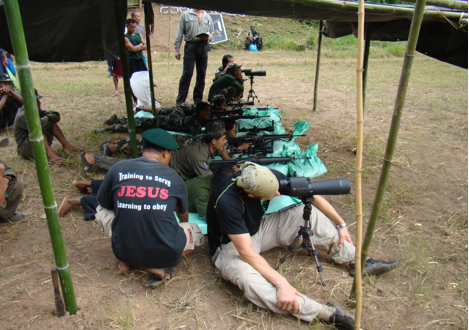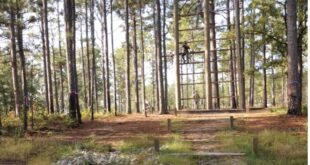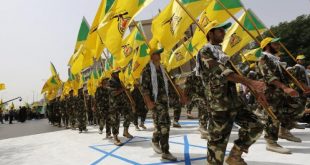By Ian Maxwell Sterling
From the December 2011 issue of SOF
Things turn hi-tech for Karen rebels in Burma
I have been up all night puking my guts out after downing a massive portion of lizard stew last night with Karen rebels in a jungle outpost. They had asked if I wanted “spicy” or “not so spicy,” and I conservatively chose “not so spicy.” Big mistake. Spices are what kill all those bad things that go ballistic in your gut here in this last major liberated area in eastern Burma. Payback time now for being timid, as timidity in any form in these deep jungles can be a real killer. My Karen National Liberation Army (KNLA) hosts survive daily on the very edge of existence in the face of a modern Burmese Army one hundred times their size. But Burmese Army morale sucks here, as the Karen young and old alike deal out death and destruction as probably the best jungle mountain fighters in the world. This is a decisive home court advantage for the Karen, who literally ate up a retreating Japanese Army here in 1945. Five years up pent-up fury was unleashed as these hill tribesmen of little means, but no shortage of courage and cunning, reputedly killed over 10,000 Japanese on the run. That was then and this is now, but after 70 years of guerrilla warfare, this attitude has been honed to a white hot cutting edge. There is no stopping it. It is the only thing in life that I am now certain of—this determination of an oppressed people balancing on the edge of survival.

“When you see your mother and sister gang raped, murdered and then dismembered right before your own family and friends, and then hear your children screaming, screaming, screaming, then you must do what you must do. Nothing can stop you, not even death. And you are not afraid of this. It means nothing. You must fight beyond death to kill those who have murdered your loved ones. The children screaming never stops. It never stops.” I listen to an old Karen private from the British Army, who speaks as if it were all yesterday. He lucidly recounts to me looking right through me as if in a trance, how he as a teenager had chased the Japanese and killed them relentlessly, driven by images of loved ones lost at brutal hands. “We hid an American Army major…Major Hart…in our village. And for this the Japanese murdered our families. All of them.”
My gut is in a knot. My video cameraman, a grizzled US Navy veteran diver, is convulsing in tears. In pitch blackness of the night and the deafening silence of the moment there is but this clear voice of one old soldier talking from out of another era, bringing it vividly, bloodily, movingly into our view as if it were all upon us right now. The horror of it all is still happening now in these same jungles at the hands of the Burmese Army. Absolutely haunting. The old soldier gets up without comment and vanishes silently into the night. We are left emotionally exhausted. No words suffice. We retreat into our own thoughts trying to make sense of what is going on here.
I have now been a time with these jungle fighters in Karen State of eastern Burma. I confess to still know precious little about them, for they are amazingly stoic and modest. They will often not even mention their names upon introduction, for shame of sounding boastful. To talk of oneself sounds out of place here. There is only time to talk about what must be done…what each soldier must do in purpose beyond self. “I must do this for my people” is a theme so often repeated that it penetrates the psyche of even the most cynical soul. But it is the deeds, not the words, that are testament to the spirit of these determined ethnic people from a bygone age. I interviewed a young Karen girl of 20 who had escaped a Burmese Army assault on her village and travelled on foot for a week alone across the toughest jungle mountains in the world …and a war zone at that… to reach our camp. When I asked her what she was going to do next, she said, “I am going to go back to find my mother and father and to help my people.” What do you say to this? Again I am again at a loss for words. The knot in my stomach will not go away.

As I focus on the camp, there is an odd mix of high and low technology all about me. I stop in on an old one-legged, one-eyed boobytrap maker smoking a pipe as he fashions an ingenious demolition triggering device made from bamboo and copper wire. Around him are hundreds of toe popper mines fashioned out of bamboo and pipe. Another chap is making piles of explosively formed projectiles (EFPs) out of bamboo. These side-attack mines for attacking mechanized / motorized vehicles launch molten copper projectiles at great distance. This comes in handy for destroying bulldozers used by the Burmese Army to carve deep into the Karen’s jungle strongholds. One of the American volunteer trainers here is a sole survivor of an EFP ambush in Iraq. Nothing quite like first-hand experience.
Off to the side, “bomb man” has constructed a variety of Limpet mines for sinking ships. These are odd, spidery-looking contraptions with legs made of magnets to stick to ship hulls. He even has one prototype totally made of a massive piece of bamboo, except for the triggering device and the magnets glued inside bamboo legs. It is typical of the Karen to want to make everything of bamboo. I am permitted to sit in on some of the training run by an old, white-bearded American Special Forces gent of Vietnam vintage, who is obviously an expert in ship attack. He speaks to a group of six hard-body swimmers in halting Karen, but adequate enough for the task at hand, because everything is hands-on training. “Do as I do” works for almost everything. This is all by-the-book scout swimmer tactics done with minimal kit consisting of little more than goggles, fins and the odd-looking anti-ship mines. You don’t have to be a rocket scientist to figure out the Karen have larger designs in mind than just sinking your average local long-tail river boat. “We have no interest in shipping here,” explains an old resistance fighter. “These young Karen and Arakan men are all from the Irrawaddy River region. Big ships…freighters… pass through their lands heading up river to China.” Got it! That said, a few months later I learned that Karen commandos sank a new Burmese Army diesel river boat on Burma’s southern river border, and I could not help but imagine “the boys” must have been warming up for missions elsewhere.
Nearby, a young Brit is teaching a high-tech class on a state-of-the art pan–tilt–zoom (PTZ) video camera system rigged up with long-range UHF transceivers. New laptops and PTZ systems are all over the place as students learn the ins and outs of this technology one most commonly associates with major metropolitan area surveillance. But in this jungle these are life-saving early warning systems run by elaborate solar power set ups, beaming back real-time video of Burmese Army movements and activities. At over $4500 a system, it is obvious that the rice-growing Karen are not funding these themselves. I stick around to watch the class and soon see that the trainer is on a SATCOM internet SKYPE connection working out a problem with the tech support office in Singapore. At over $1.50 a minute, this is expensive comms, but they seem in no rush. “We have good international friends who want us to win,” is the reply.
In an adjacent bamboo classroom, another foreign trainer is showing how to rig modern mobile phones to hard drives and battery packs to turn a phone’s video camera into a surveillance system with 1 terabyte storage capacity. These are ingeniously booby trapped, in case they fall into enemy hands. Mini spy cameras of all shapes and sizes are in the hands of trainees learning how to manipulate them. This particular class is being taught by an international human rights investigator fresh from working with underground activists in Vietnam.

with Leupold spotting scopes and Bushnell laser range finders. Costly kit from good friends in America. This particular gun knocked out a microwave radar dish.
When I asked what was going on, he said: “It’s all about accumulating massive video evidence of human rights abuses. The Burmese Army’s scorched earth policy has left thousands of ethnic minority villages in ashes. Their atrocities are horrific beyond belief, earning the regime one of the worst human rights records in the world. We are going to send people in high places to jail in The Hague for a very long time. Time is totally on our side, as more evidence just means surer convictions. The repressive Burmese regime can say whatever it wants, but our video will tell the real truth. Whom do you really think the world is going to believe? We have stuff now that will absolutely rock you. We will hold it all until the time is ripe to take down the right people. Take them down hard. We call it ‘Strategic Video Ambush.’ It’s sort of like mixing YouTube with lawyers in a deadly pay-back cocktail. The Burmese regime simply cannot handle the truth. So also with some of the international corporations making billions of dollars here on natural resources at the expense of ethnic minorities’ lives. We are going after them too. They are the ultimate bad guys here.”
I stop off at dusk at the engineer shop, where a middle-aged Karen is working on a machine with which he has fashioned big metal rings used for building noise suppressors for .22 rifles. “This is the hard way to make a silencer, but these last a long time. We make others out of pipe and filled with layers of window screen cut in circles, plus a few other ingredients.” I had heard of this method used by the OSS on .45 cal M3 “grease guns.” “Very good for silent death.” He laughs. The .22 has a flat trajectory and is optimal in the jungle, where shots are taken at close range. I recall that I had spoken with a Karen commander a year earlier, and he had sworn by them as accurate, silent and cheap. This guy was a real killer, too, going on many sniper missions. I got the distinct impression he was the trigger man himself. The machine the engineer is working on is an ancient, coughing Chi-Com beast, but rugged as hell. It works like a champ in this muggy climate that eventually rots everything in the end. “We have more of these in other locations, so no problem.”
Modern red- and yellow-colored Chinese diesel generators provide the primary power, and massive solar power arrays with what look like golf cart batteries provide the back-up. Got to love Chinese technology, but I personally hate the Chinese. They are the big backers of the Burmese government and keep its army well provisioned. Yes, China may be backing the Burmese, but simple Chinese technology, old and new, is helping the Karen to kill Burmese soldiers with staggering KIA ratios. That’s jungle justice for you. Fair enough.
The night here creeps up on you and once the sun drops behind the mountains, it turns blackest black on starless nights. All night long crickets, locusts, frogs and all sorts of creatures make a continuous racket, which is actually a Godsend. It’s when they stop making noise that you have to worry, because that usually means someone is out there moving who is not supposed to be there. The bad guys are gunning for Western trainers lending a hand here. Minefields, booby traps and night vision-scoped rifles are the reception committee for this. Sometimes the dangers are unexpected. It’s just that you have to be pretty careful yourself doing basic things, such as going to the latrine at night. Last fall one of the SF trainers…the Limpet mine guy… almost died when he fell off a cliff right next to his jungle hammock while trying to take a leak. Nothing like surviving multiple combat tours in Vietnam and then falling to your death on the way to the shitter in Burma. Bummer.
With a relatively good night’s sleep behind me, I am now fully recovered from the lizard stew experience. I peer out of my hammock early in the morning at the sound of scurrying feet on the trail nearby. A squad of Karen are hustling along past my hooch, each with an SA-7 anti-air missile over his shoulder. I had seen one by chance here before, but now it was apparent to me the Karen had a considerable anti-aircraft capability. Other soldiers followed with RPG-7s and the Karen’s homemade version of Barrett .50 cal sniper guns. All in all about 30-plus soldiers move in silence down the trail. It was explained to me at breakfast that this was a new anti-helicopter unit formed because of the Burmese Army’s recent acquisition of Mi-24 helicopters. I tried to get more information, but nobody seemed to want to go into details, so I had to back off for fear of showing bad style. The Sri Lankan Army used Mi-24s effectively in finally beating the Tamil Tigers and the Karen are well aware that the Burmese Army has recently purchased a sizeable fleet of the same choppers. An old US veteran who worked with mujahideen fighters against the Soviets long ago in Afghanistan is the primary trainer for this new Karen anti-air mission. The Karen attitude is one of positive anticipation, particularly after regrettably hearing of Taliban success of late with RPGs. “Let the Burmese helicopters come!”
At dinner there are fresh faces in camp and I am introduced to three fresh-shaved American businessmen in pretty good shape, who are all decked out for what looks like an extravagant eco-tour….all the latest CQ outdoor trekking technology among their kit. They pepper me with questions about the Karen and other ethnic resistance situations in Burma. After a while it becomes pretty clear to me these gents are indeed interested in the plight of these oppressed people, but they are also keenly, if not conspicuously, aware of the natural resource wealth in the region. So I ask them point blank what their agenda is.
 “Look, it is pretty clear to us the Burmese Army is never going to beat these ethnic resistance movements. The fighting has been going on for decades and resistance movements are getting stronger. Anyone with a basic understanding of unconventional warfare history knows that guerrillas in a jungle setting can attack critical lines of communication indefinitely with almost no resources. So who are the big losers here? We think it’s Burma, China and whoever else is backing Burma, because big economic development is never going to take place, such as mega-billion dollar hydro power dam projects and Burma’s deep water sea port initiative, until the guerrillas become economic stakeholders. We are banking on guerrillas to be the winners in the end. You cannot murder people for decades and hope to get away with it. Look at what has happened across North Africa. People are not going to allow oppressive governments to shit on them indefinitely. We sure didn’t come here because of the great chow. There is money to be made here, provided you bet on the right pony. Count on it.” Deep in thought, my only reply was: “Yeh, but stay away from the lizard stew.”
“Look, it is pretty clear to us the Burmese Army is never going to beat these ethnic resistance movements. The fighting has been going on for decades and resistance movements are getting stronger. Anyone with a basic understanding of unconventional warfare history knows that guerrillas in a jungle setting can attack critical lines of communication indefinitely with almost no resources. So who are the big losers here? We think it’s Burma, China and whoever else is backing Burma, because big economic development is never going to take place, such as mega-billion dollar hydro power dam projects and Burma’s deep water sea port initiative, until the guerrillas become economic stakeholders. We are banking on guerrillas to be the winners in the end. You cannot murder people for decades and hope to get away with it. Look at what has happened across North Africa. People are not going to allow oppressive governments to shit on them indefinitely. We sure didn’t come here because of the great chow. There is money to be made here, provided you bet on the right pony. Count on it.” Deep in thought, my only reply was: “Yeh, but stay away from the lizard stew.”
By morning, these gents were gone, moving deeper inside, I reckon, but their forecast of things to come still lingered. I cannot help but wonder what ultimate fate awaits the Karen and other ethnic minorities here, as many suitors seem to be so keenly focused on the natural resource wealth of this exotic land. I recall an old village leader and veteran of World War II once telling me: “We simple Karen have not been smart, but the Burmese have been most cunning. We only know that first we must pray, then we will know what to do and then we must do it. And then we will die, but we will never surrender.” As I reflect on the old man’s words and think of that young refugee girl’s determination to go back on her own across a war zone to find her parents, I cannot help but be struck by the power of this human will and its high purpose. The Karen, in their clear sense of duty in the face of overwhelming odds, have an awesome weapon. “Live free or die” as the telltale sign at the entrance to this camp reads. This is indeed a spirit worth backing.
 Soldier of Fortune Magazine The Journal of Professional Adventurers
Soldier of Fortune Magazine The Journal of Professional Adventurers






